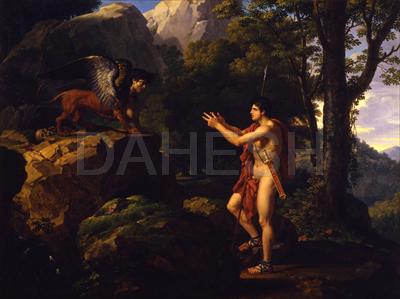Baron François-Xavier Fabre (French, 1766–1837)
Oedipus and the Sphinx, ca. 1806–1810
Oil on canvas, 19 3/4 x 26 in.
2001.3

A pupil of the neoclassical painter Jacques-Louis David (1748-1825), Fabre portrayed the dramatic moment when the deadly Sphinx confronts young Oedipus with her riddle: “What is that which at dawn walks on four legs, at midday on two, and in the evening on three?” Oedipus masterfully replies “Man,” who as an infant crawls on all fours, as a man stands on two feet, and in old age uses a staff as a third limb.
Fabre placed Oedipus in a beautifully staged neo-classical landscape, gave him the likeness of the prototypical, well-formed Greek hero, and had him gesture dramatically with three fingers stretched, leaving no doubt that he would answer the riddle successfully. This legend also inspired another of David’s students, Jean-Auguste-Dominique Ingres (1780–1867), who began painting his own version in Rome in 1808 (Musée du Louvre, Paris). One can only speculate whether the artists knew of each other’s work, as both where living in Italy at that time.
When this work underwent a slight surface cleaning, it was discovered that a small area behind the Sphinx had in fact been painted over; the human skull and parts of a skeleton underneath are now again visible. This graphic detail is a logical element within the story, as the Sphinx devoured anyone who could not solve the riddle. However, the skull must have seemed too gruesome a detail to some previous owner, who then had it covered.


